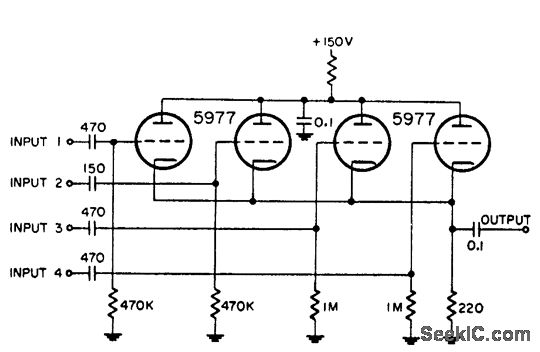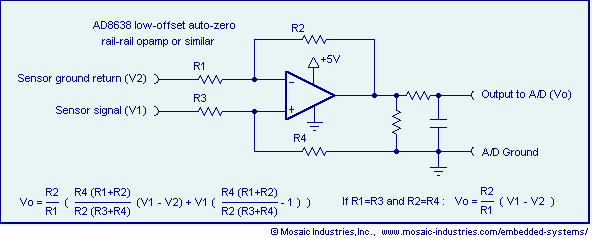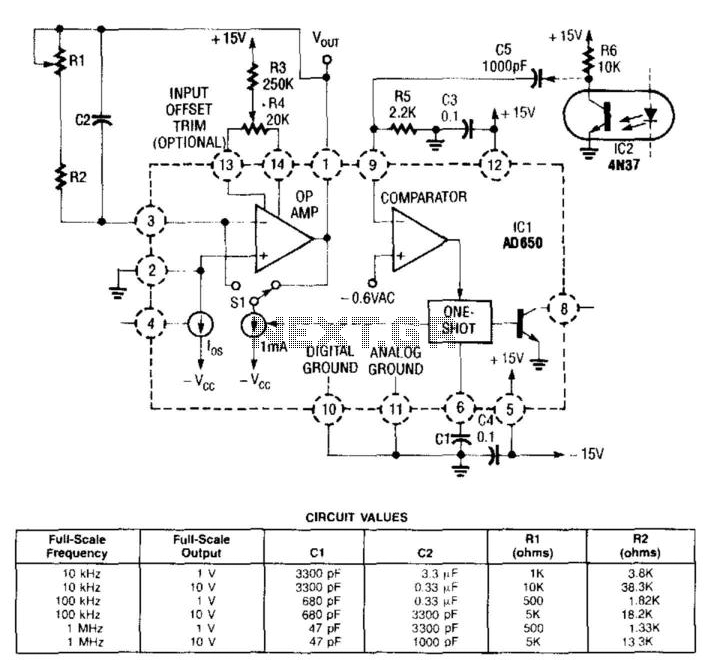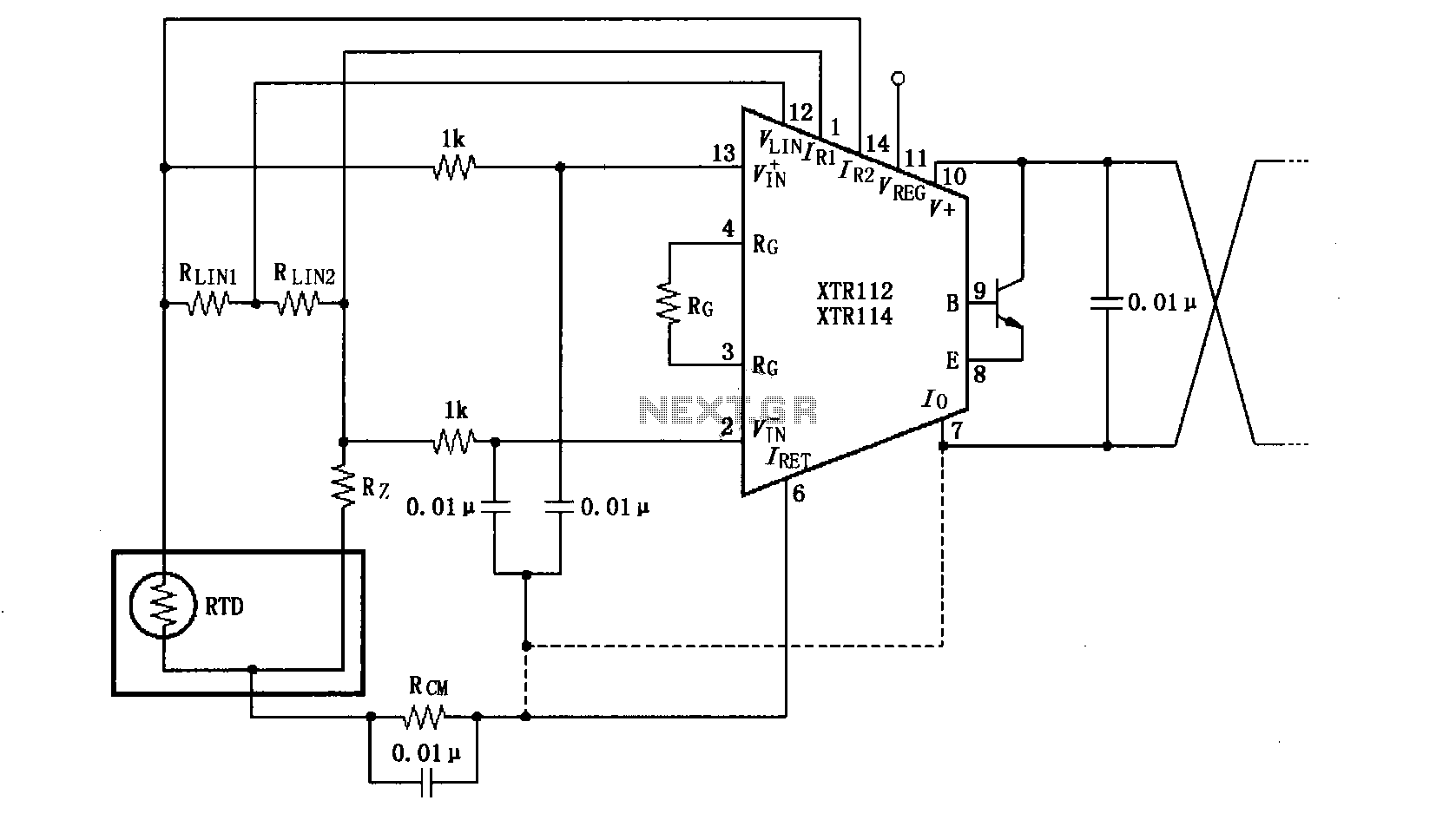
Input programming activity
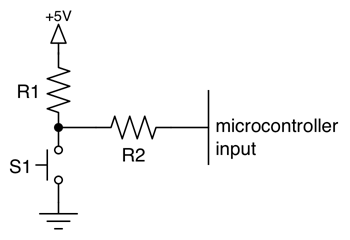
The function of the TRIS registers, specifically TRISA and TRISB, governs the data transfer direction for each pin on Port A and Port B, respectively. A mnemonic to remember the TRIS register settings is to associate the numbers 0 and 1 with the letters O and I. The CHRP circuit board features various input circuits, including pushbutton switches, phototransistors (light sensors), and a potentiometer (position sensor). These inputs operate in a similar, albeit slightly different manner. The switch input schematic diagram illustrates this: the switch (S1) and pull-up resistor (R1) create a series circuit, functioning as a voltage divider. The microcontroller input connects to the midpoint of the voltage divider, allowing it to sense the electrical potential across the switch. Since microcontroller pins configured as inputs exhibit high impedance, they detect externally applied voltage without conducting significant current. Consequently, the series resistor (R2) between the voltage divider and the microcontroller has a negligible effect and can be disregarded. R2 is included to limit current due to electrostatic discharge (ESD), protecting the microcontroller from static charges introduced into the switch circuit by user interaction. When analyzing the switch input circuit, the interaction between the switch and pull-up resistor R1 can be understood through either Ohm's law or voltage divider principles. According to Ohm's law, when the switch is open, no current flows through the pull-up resistor, resulting in zero voltage loss across it. Thus, the microcontroller input pin detects the full power supply voltage of 5V, indicating a logic 1. Conversely, when the switch is pressed, current flows through both the switch and resistor. With the switch effectively presenting zero resistance, there is no voltage loss across it. Ohm's law indicates that the current flowing through the resistor leads to all applied voltage being dissipated across it, causing the microcontroller to sense ground potential (0V), or a logic 0. From the voltage divider perspective, the two series elements divide the applied voltage based on their resistances. The voltage at the midpoint of the switch circuit is proportional to the switch resistance, which is either infinite (switch open) or zero (switch closed). An open switch results in its infinite resistance being significantly greater than that of the pull-up resistor, causing the entire voltage to be measured across the switch, yielding a logic 1 (5V). When the switch is closed, its ideally zero resistance is much smaller than that of the pull-up resistor, leading to no voltage drop across the switch and producing a logic 0 (0V).
The input for the potentiometer is managed digitally through assembly code, which is structured for compatibility with the MPLAB development environment and the specific processor, in this case, the PIC16F676. The configuration settings include disabling the comparator, turning off the brown-out reset, and enabling the power-up timer while disabling the watchdog timer. The hardware equates define the pin assignments for the switch and potentiometer on Port A. The program memory begins with an oscillator calibration routine, ensuring that the oscillator operates within specified parameters. The initialization process involves configuring the ports for digital input and output, ensuring that the system is prepared for interaction with the defined input circuits. The assembly code effectively sets up the microcontroller to handle the various input signals, allowing for the digital processing of signals from the potentiometer and other input devices. This systematic approach to input handling is crucial for the reliable operation of the circuit board in various applications.Now, let`s re-examine the function of the TRIS registers. The TRISA and TRISB registers control the direction of data transfer on each pin of Port A and Port B, respectively. The easy way to remember the TRIS register settings is to match the numbers 0 and 1 to the letters O and I: The CHRP circuit board includes a number of input circuits, such a
s pushbutton switches, phototransistors (light sensors), and a potentiometer (position sensor). All of these inputs operate in a similar, though slightly different way. Examine the switch input schematic diagram, below: The switch (S1) and pull-up resistor (R1) form a series circuit, also known as a voltage divider. The microcontroller input is connected to the output at the mid-point of the voltage divider, and senses the electrical potential across the switch.
Since any microcontroller pins configured as inputs have a high impedance, they will just sense the externally applied voltage but won`t conduct any appreciable current themselves. This essentially means that the effect of the series resistor (R2) between the voltage divider and the microcontroller is negligible and can be safely ignored ”R2 is installed to limit the current due to ESD (electro-static discharge), protecting the microcontroller from static charges conducted into the switch circuit by a user`s fingers.
Ignoring R2, the operation of the switch input circuit can be explained by the interaction of the switch and pull-up resistor R1. You can think about how this works either by Ohm`s law analysis, or by thinking about it as a voltage divider.
Using Ohm`s Law analysis, we know that when the switch is open, no current flows through the pull-up resistor. Since no current flows, the voltage loss across the resistor is zero, and the microcontroller input pin senses the full power supply voltage connected to the resistor ”5V, or a logic 1.
You could say the resistor pulled-up the switch circuit voltage to 5V. When the switch is pressed, current flows through both the switch and resistor. Since the switch has effectively zero resistance, there is a zero volt loss across the switch. Ohm`s Law shows that the current flow through the resistor causes all of the applied voltage to be dissipated across the resistor, and so the microcontroller ends up sensing the ground potential, 0V, or a logic 0. Thinking about the circuit as a voltage divider, we know that the two elements in a series circuit divide the applied voltage in the ratio of their resistances.
The voltage at the mid-point of the switch circuit will be proportional to the resistance of the switch, which has either infinite resistance (switch open), or zero resistance (switch closed). When the switch is open, its infinite resistance is infinitely higher than that of the pull-up resistor, causing the entire applied voltage to be measured across the switch, and producing a logic 1 (5V).
When the switch is closed, its (ideally) zero resistance is infinitely smaller than that of the pull-up resistor, causing no voltage drop, and producing a logic 0 (0V). ;INPUT-POT. ASM v2. 0 Last modified on August 3, 2010 ;= ;Senses potentiometer input digitally. ;Start of MPLAB and processor configuration. include "p16f676. inc" ;Include processor definitions _config _CPD_OFF & _CP_OFF & _BODEN_OFF & _MCLRE_OFF & _PWRTE_ON & _WDT_OFF & _INTRC_OSC_NOCLKOUT ;End of MPLAB and processor configuration.
;Start of hardware equates. S1 equ 3 ;Switch S1 Port A bit position P1 equ 4 ;Potentiometer P1 Port A bit position org 3FFh ;Oscillator calibration location oscillator org 00h ;Start of program memory bsf STATUS, RP0 ;Select memory register page 1 call oscillator ;Store pre-programmed oscillator calibration movwf OSCCAL ;constant in OSCCAL register goto init ;Start program after Interrupt vector org 05h ;Continue after interrupt vector init ;Initialize ports A and C for digital I/O bcf STATUS, RP0 movlw 7 ;Disable comparator and m 🔗 External reference
The input for the potentiometer is managed digitally through assembly code, which is structured for compatibility with the MPLAB development environment and the specific processor, in this case, the PIC16F676. The configuration settings include disabling the comparator, turning off the brown-out reset, and enabling the power-up timer while disabling the watchdog timer. The hardware equates define the pin assignments for the switch and potentiometer on Port A. The program memory begins with an oscillator calibration routine, ensuring that the oscillator operates within specified parameters. The initialization process involves configuring the ports for digital input and output, ensuring that the system is prepared for interaction with the defined input circuits. The assembly code effectively sets up the microcontroller to handle the various input signals, allowing for the digital processing of signals from the potentiometer and other input devices. This systematic approach to input handling is crucial for the reliable operation of the circuit board in various applications.Now, let`s re-examine the function of the TRIS registers. The TRISA and TRISB registers control the direction of data transfer on each pin of Port A and Port B, respectively. The easy way to remember the TRIS register settings is to match the numbers 0 and 1 to the letters O and I: The CHRP circuit board includes a number of input circuits, such a
s pushbutton switches, phototransistors (light sensors), and a potentiometer (position sensor). All of these inputs operate in a similar, though slightly different way. Examine the switch input schematic diagram, below: The switch (S1) and pull-up resistor (R1) form a series circuit, also known as a voltage divider. The microcontroller input is connected to the output at the mid-point of the voltage divider, and senses the electrical potential across the switch.
Since any microcontroller pins configured as inputs have a high impedance, they will just sense the externally applied voltage but won`t conduct any appreciable current themselves. This essentially means that the effect of the series resistor (R2) between the voltage divider and the microcontroller is negligible and can be safely ignored ”R2 is installed to limit the current due to ESD (electro-static discharge), protecting the microcontroller from static charges conducted into the switch circuit by a user`s fingers.
Ignoring R2, the operation of the switch input circuit can be explained by the interaction of the switch and pull-up resistor R1. You can think about how this works either by Ohm`s law analysis, or by thinking about it as a voltage divider.
Using Ohm`s Law analysis, we know that when the switch is open, no current flows through the pull-up resistor. Since no current flows, the voltage loss across the resistor is zero, and the microcontroller input pin senses the full power supply voltage connected to the resistor ”5V, or a logic 1.
You could say the resistor pulled-up the switch circuit voltage to 5V. When the switch is pressed, current flows through both the switch and resistor. Since the switch has effectively zero resistance, there is a zero volt loss across the switch. Ohm`s Law shows that the current flow through the resistor causes all of the applied voltage to be dissipated across the resistor, and so the microcontroller ends up sensing the ground potential, 0V, or a logic 0. Thinking about the circuit as a voltage divider, we know that the two elements in a series circuit divide the applied voltage in the ratio of their resistances.
The voltage at the mid-point of the switch circuit will be proportional to the resistance of the switch, which has either infinite resistance (switch open), or zero resistance (switch closed). When the switch is open, its infinite resistance is infinitely higher than that of the pull-up resistor, causing the entire applied voltage to be measured across the switch, and producing a logic 1 (5V).
When the switch is closed, its (ideally) zero resistance is infinitely smaller than that of the pull-up resistor, causing no voltage drop, and producing a logic 0 (0V). ;INPUT-POT. ASM v2. 0 Last modified on August 3, 2010 ;= ;Senses potentiometer input digitally. ;Start of MPLAB and processor configuration. include "p16f676. inc" ;Include processor definitions _config _CPD_OFF & _CP_OFF & _BODEN_OFF & _MCLRE_OFF & _PWRTE_ON & _WDT_OFF & _INTRC_OSC_NOCLKOUT ;End of MPLAB and processor configuration.
;Start of hardware equates. S1 equ 3 ;Switch S1 Port A bit position P1 equ 4 ;Potentiometer P1 Port A bit position org 3FFh ;Oscillator calibration location oscillator org 00h ;Start of program memory bsf STATUS, RP0 ;Select memory register page 1 call oscillator ;Store pre-programmed oscillator calibration movwf OSCCAL ;constant in OSCCAL register goto init ;Start program after Interrupt vector org 05h ;Continue after interrupt vector init ;Initialize ports A and C for digital I/O bcf STATUS, RP0 movlw 7 ;Disable comparator and m 🔗 External reference

